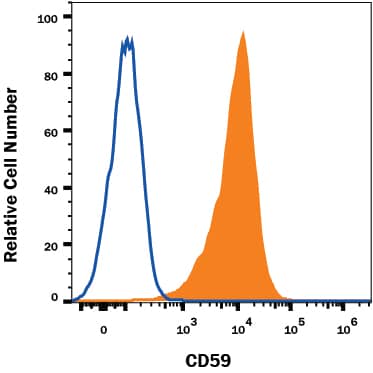Human CD59 Antibody
R&D Systems, part of Bio-Techne | Catalog # MAB1987
Recombinant Monoclonal Antibody.


Conjugate
Catalog #
Key Product Details
Species Reactivity
Human
Applications
CyTOF-ready, Flow Cytometry
Label
Unconjugated
Antibody Source
Recombinant Monoclonal Rabbit IgG Clone # 2491C
Product Specifications
Immunogen
Mouse myeloma cell line, NS0-derived recombinant human CD59
Leu26-Asn102
Accession # P13987
Leu26-Asn102
Accession # P13987
Specificity
Detects human CD59 in direct ELISAs.
Clonality
Monoclonal
Host
Rabbit
Isotype
IgG
Scientific Data Images for Human CD59 Antibody
Detection of CD59 in Human PBMC lymphocytes by Flow Cytometry.
Human PBMC lymphocytes were stained with Rabbit Anti-Human CD59 Monoclonal Antibody (Catalog # MAB1987, filled histogram) or isotype control antibody (Catalog # MAB1050, open histogram) followed by anti-Rabbit IgG PE-conjugated secondary antibody (Catalog # F0110). View our protocol for Staining Membrane-associated Proteins.Applications for Human CD59 Antibody
Application
Recommended Usage
CyTOF-ready
Ready to be labeled using established conjugation methods. No BSA or other carrier proteins that could interfere with conjugation.
Flow Cytometry
0.25 µg/106 cells
Sample: Human PBMC lymphocytes
Sample: Human PBMC lymphocytes
Formulation, Preparation, and Storage
Purification
Protein A or G purified from cell culture supernatant
Reconstitution
Reconstitute at 0.5 mg/mL in sterile PBS. For liquid material, refer to CoA for concentration.
Formulation
Lyophilized from a 0.2 μm filtered solution in PBS with Trehalose. *Small pack size (SP) is supplied either lyophilized or as a 0.2 µm filtered solution in PBS.
Shipping
Lyophilized product is shipped at ambient temperature. Liquid small pack size (-SP) is shipped with polar packs. Upon receipt, store immediately at the temperature recommended below.
Stability & Storage
Use a manual defrost freezer and avoid repeated freeze-thaw cycles.
- 12 months from date of receipt, -20 to -70 °C as supplied.
- 1 month, 2 to 8 °C under sterile conditions after reconstitution.
- 6 months, -20 to -70 °C under sterile conditions after reconstitution.
Background: CD59
References
- Ricklin, D. et al. (2010) Nat. Rev. Immunol. 11:785.
- Farkas, I. et al. (2002) J. Physiol. 539:537.
- Meri, S. et al. (1990) Immunology 71:1.
- Rollins, S.A. and P.J. Sims (1990) J. Immunol. 144:3478.
- Rollins, S.A. et al. (1991) J. Immunol. 146:2345.
- Turnberg, D. et al. (2004) Am. J. Physiol. 165:825.
- Zhang, J. et al. (2011) Am. J. Pathol. 179:2876.
- Wu, G. et al. (2009) Circ. Res. 104:550.
- Wu, G. et al. (2010) Circulation 121:1338.
- Acosta, J. et al. (2000) Proc. Natl. Acad. Sci. USA 97:5450.
- Giddings, K.S. et al. (2004) Nat. Str. Mol. Biol. 11:1173.
- Amet, T. et al. (2012) Hepatology 55:354.
- Xie, X.-H. et al. (2012) Cell. Immunol. 274:1.
- Marcenaro, E. et al. (2003) Eur. J. Immunol. 33:3367.
- Sugita, Y. et al. (1989) J. Biochem. 106:555.
Alternate Names
CD59, HRF20, MACIF, MIC11, Protectin
Entrez Gene IDs
966 (Human)
Gene Symbol
CD59
UniProt
Additional CD59 Products
Product Documents for Human CD59 Antibody
Product Specific Notices for Human CD59 Antibody
For research use only
